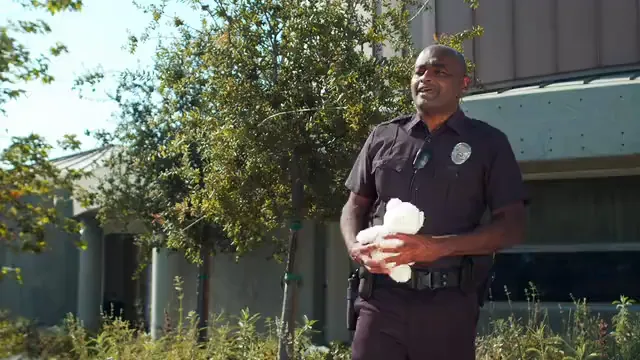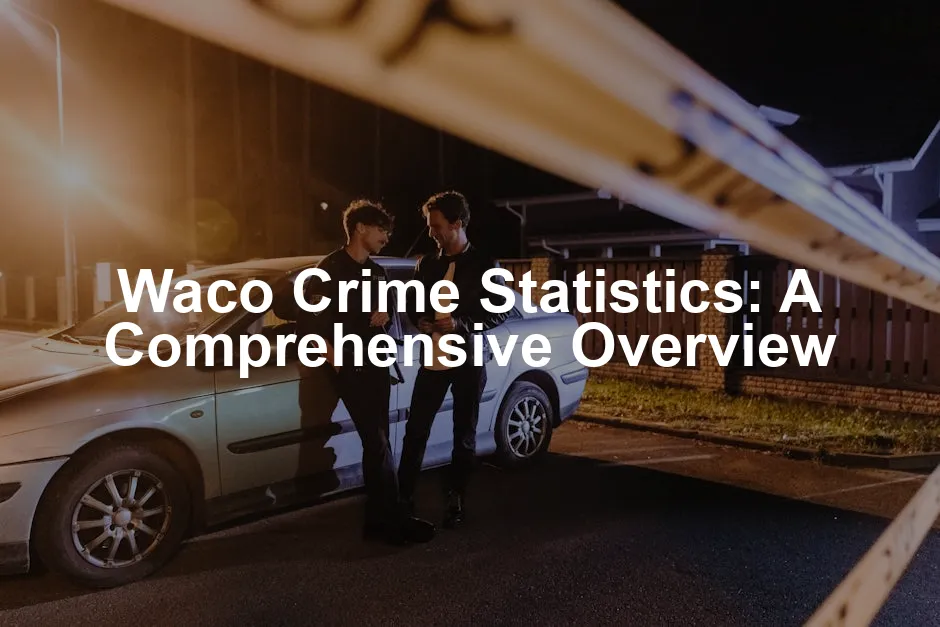Introduction
Welcome to Waco, Texas! Known for its rich history, vibrant culture, and the famous Magnolia Market, Waco has a special place in the heart of Texas. However, like many cities, it faces its share of crime challenges. Understanding the crime landscape is crucial for residents, potential visitors, and policymakers alike.
Crime statistics serve as a mirror reflecting the safety and security of a community. For residents, these numbers can inform personal safety decisions. For visitors, they help gauge the overall vibe of a place. And for policymakers, data-driven insights guide effective law enforcement and community programs.
This article aims to provide a thorough analysis of Waco’s crime statistics. We’ll look at trends, comparisons with state and national averages, and safety measures in place. Whether you’re a lifelong Wacoan or planning a visit, having knowledge about crime in the area is paramount. So, let’s jump into the nitty-gritty of Waco’s crime statistics and unlock some important insights!

Understanding Waco Crime Statistics
What Are Crime Statistics?
Crime statistics are numerical representations of criminal activities reported within a specific area and timeframe. These statistics help illuminate patterns in crime, allowing communities to allocate resources effectively and address safety concerns.
The sources of crime data primarily include local law enforcement agencies, which compile reports from incidents across the city. Additionally, the FBI collects nationwide data through its Uniform Crime Reporting (UCR) Program, providing a broader context for understanding crime trends.
Scope of Crime Data in Waco
Waco’s latest crime statistics reveal a total of 5,537 reported crimes, with 908 classified as violent crimes and 4,629 as property crimes. The crime rate stands at 38.46 per 1,000 residents, with violent crime at 6.31 per 1,000 and property crime at 32.15 per 1,000 residents.
When we compare these numbers to Texas state averages, Waco’s violent crime rate is significantly higher than the Texas average of 4.32 per 1,000 residents. Similarly, the property crime rate of 32.15 exceeds the state average of 23.0 per 1,000 residents.
Understanding these statistics is vital for grasping the safety landscape in Waco. They provide a snapshot of the challenges the city faces, as well as areas where improvements may be needed. By analyzing these figures, residents can make informed choices while local authorities can tailor their strategies to enhance community safety.
Speaking of community safety, have you considered enhancing your home security? Investing in a Home Security System with Camera can provide peace of mind, keeping an eye on your property even when you’re not around. After all, a little extra security never hurt anyone!
For a comprehensive analysis of Waco’s crime statistics, you can refer to this detailed report on Waco Texas Crime Statistics.

Detailed Analysis of Crime Rates
Total Crime Overview
Waco, Texas, has a total of 5,537 reported crimes, which is quite a hefty number. Among these, 908 are violent crimes, while a staggering 4,629 fall under the property crime category. This breakdown highlights a significant disparity, with property crimes dominating the statistics.
To put these figures into perspective, the crime rate in Waco stands at 38.46 per 1,000 residents. When we look at the violent crime rate, it’s notably higher at 6.31 per 1,000. In contrast, property crime claims the lion’s share with a rate of 32.15 per 1,000 residents. The numbers indeed paint a broad picture of the crime landscape in Waco, sparking curiosity about the various types of crimes committed here.

Violent Crime Breakdown
Murder: Waco reported 14 murders, a figure that raises eyebrows. Over recent years, the murder rate has fluctuated, but it remains a crucial point of concern. Understanding the root causes can help mitigate these alarming figures.
Rape: The statistics show that there were 117 reported cases of rape. This number indicates a troubling trend in sexual violence, echoing historical patterns that suggest a need for community awareness and prevention strategies.
Robbery: Robbery cases totaled 106, which indicates a slight uptick compared to previous years. Factors contributing to these numbers can include economic challenges and social dynamics that might push individuals towards such crimes.
Assault: Assault incidents dominate the violent crime category, with a whopping 671 reported cases. This high prevalence suggests a pressing need for intervention strategies, community outreach, and support programs aimed at violence prevention.

Property Crime Breakdown
Burglary: The burglary statistics reveal 757 incidents, which is alarming for a city of Waco’s size. The community must engage in preventive measures and increase awareness of security practices to lower these numbers.
Theft: The most significant contributor to property crime is theft, with an astonishing 3,491 cases reported. This overwhelming number signifies that Waco faces a theft crisis, likely driven by various socio-economic factors. Residents should consider protective measures to safeguard their belongings. A Smart Door Lock can be a simple yet effective way to enhance your home’s security.
Motor Vehicle Theft: Waco also sees a notable rate of motor vehicle theft, with 381 reported incidents. This statistic raises concerns about vehicle security and the effectiveness of law enforcement in curbing this issue.
In summary, Waco’s crime statistics reveal a complex tapestry of challenges. The figures indicate that while violent crimes demand urgent attention, property crimes, particularly theft, remain a significant concern for residents. Understanding these trends is vital in fostering a safer community and encouraging proactive measures among citizens and local authorities alike.

Crime Trends Over the Years
Historical Context
Waco has seen fluctuating crime trends over the past decade. Historically, crime rates have witnessed both peaks and dips, painting a complex picture of safety in the city. Here’s a look at the year-on-year changes in various crime categories over the last five years:
| Year | Total Crimes | Violent Crimes | Property Crimes |
|---|---|---|---|
| 2019 | 5,456 | 906 | 4,550 |
| 2020 | 5,537 | 908 | 4,629 |
| 2021 | 5,442 | 908 | 4,534 |
| 2022 | 5,256 | 873 | 4,383 |
| 2023 | 4,550 | 787 | 3,763 |
The table reveals some notable insights. The total crime rate peaked in 2020, followed by a gradual decline in subsequent years. Violent crime has also shown a significant downward trend, particularly in 2023, where it reached a low of 787 incidents. This decline reflects a growing community effort toward safety and crime prevention.

Recent Developments
In 2023, Waco reported a significant 13% reduction in violent crimes compared to 2022. This decrease is attributed to various community initiatives and stronger police presence. The breakdown of the latest data shows that there were 2,035 violent crimes reported from January to November 2023, down from 2,346 the previous year.
Seasonal trends also play a role in crime rates. Historically, summer months tend to see a spike in certain crimes, particularly theft and property-related incidents, as people are more active and traveling. However, community outreach and police engagement have helped mitigate these seasonal spikes.
Overall, the latest statistics signal a positive direction for Waco, with law enforcement and community members working together to enhance safety and reduce crime rates. And if you’re planning on traveling this summer, don’t forget to check out this Travel Guide for Texas to make the most of your trip!

Community Response to Crime
Law Enforcement Initiatives
The Waco Police Department is actively combating crime through various innovative measures. Community outreach programs have become a cornerstone of their strategy. Initiatives such as the Citizens on Patrol and Public Outreach Programs engage residents directly, fostering trust between law enforcement and the community.
Community policing has proven effective in building relationships and enhancing safety. Officers often participate in local events, allowing them to connect with residents on a personal level. This approach not only improves communication but also encourages community participation in crime prevention efforts.
Local partnerships with organizations and schools further strengthen these initiatives. Programs like the Junior Police Academy educate young people about safety and law enforcement, nurturing a sense of responsibility in future generations. And if you’re looking to empower the youth in your community, consider gifting them a copy of Community Policing: Principles and Practices. It’s a great way to inspire them to engage with their community!

The effectiveness of these strategies is visible in the recent decrease in violent crime. Chief of Police Sheryl Victorian emphasizes the importance of community connections. She notes that positive relationships lead to increased public awareness and proactive measures against crime.
In summary, Waco’s law enforcement has made substantial strides in addressing crime through community engagement and outreach programs. These initiatives not only enhance safety but also empower residents to take an active role in creating a safer environment for all.

Community Sentiment
Waco residents have mixed feelings about safety in their neighborhoods. Recent surveys reveal that 54% of locals feel pretty safe, while 46% express concerns about crime. This split reflects a community grappling with its safety image.
When it comes to law enforcement, 46% of respondents believe police are visible and responsive. However, 32% feel that while police are present, their response times could be better. Interestingly, only 2% think the police aren’t reliable at all. This suggests a generally favorable view of law enforcement, yet there’s room for improvement in community policing efforts.
Residents are keen on building relationships with police. Many believe that stronger connections could lead to safer streets. It seems that Wacoans are ready to work together to create a more secure environment.

Recommendations for Residents
Staying safe in Waco requires vigilance and community involvement. Here are some practical tips for residents and visitors alike:
- Stay Aware: Pay attention to your surroundings. Avoid distractions like your phone, especially in unfamiliar areas.
- Lock It Up: Always secure your home and vehicle. Simple actions can prevent many property crimes.
- Get Involved: Join neighborhood watch programs. These initiatives foster strong community ties and help deter crime.
- Communicate: Share safety concerns with local law enforcement. Reporting suspicious activity can make a significant difference.
- Educate Yourself: Attend local safety workshops. Knowledge is power when it comes to crime prevention.
- Utilize Resources: Take advantage of community programs aimed at enhancing safety. Engaging with neighborhood events fosters camaraderie and vigilance.
By adopting these recommendations, residents can contribute to a safer Waco. When the community comes together, it can create a positive impact on crime rates and foster a sense of security for everyone. And for those who like to be prepared, consider investing in an Emergency Preparedness Kit. It’s always better to be safe than sorry!

Comparison with Similar Cities
Crime Rate Comparisons
Waco’s crime statistics paint an intriguing picture when compared to nearby cities like Hewitt and Woodway. In 2022, Waco reported a staggering total of 5,537 crimes, with a violent crime rate of 6.31 per 1,000 residents. In contrast, Hewitt had a significantly lower violent crime rate of 0.86 per 1,000 residents, and Woodway reported a mere 0.53 per 1,000.
When it comes to property crime, Waco’s rate stands at 32.15 per 1,000, which is markedly higher than Hewitt’s 6.22 and Woodway’s 10.12. This stark contrast highlights the challenges Waco faces in maintaining safety compared to its neighbors.

Furthermore, Waco’s crime rate is notably higher than the national average. While the national average for violent crime is around 4.0 per 1,000 residents, Waco’s figures are significantly elevated. This discrepancy emphasizes the need for continued attention to crime prevention in Waco. If you’re looking for insightful reading material on the subject, check out Crime and Punishment in America. It provides a deeper understanding of crime dynamics!
Factors Influencing Crime Rates
Several socio-economic factors contribute to Waco’s crime rates. Economic disparity is a significant driver, as neighborhoods with higher poverty levels often experience increased crime rates. Waco’s median household income is lower than both the national and Texas averages, which can lead to higher instances of property crime and theft.
Additionally, education plays a crucial role. Areas with lower educational attainment tend to see higher crime levels. Waco has been actively working on initiatives to enhance educational opportunities, which can help mitigate crime in the long run. For anyone interested in understanding the societal implications of these issues, consider picking up a copy of The New Jim Crow: Mass Incarceration in the Age of Colorblindness. It delves into the systemic issues surrounding crime and justice.
Another factor is the population density. Waco’s density is higher than both Hewitt and Woodway, leading to more interactions. This can increase the potential for crime as more individuals share spaces.

Overall, while Waco faces unique challenges, understanding these factors can aid in developing effective strategies for reducing crime and improving community safety. Engaging residents and fostering collaboration with law enforcement will be essential in building a safer environment for all.

Conclusion
In wrapping up our exploration of Waco’s crime statistics, several key findings paint a vivid picture of the city’s safety landscape. With a total of 5,537 reported crimes, Waco faces significant challenges. Among these, 908 are violent crimes, including 14 murders—a sobering statistic that prompts concern among residents and visitors alike. Property crimes, particularly theft, dominate the statistics, accounting for a staggering 4,629 incidents. This stark reality emphasizes the need for ongoing dialogue and action regarding community safety.
Understanding these statistics isn’t just an academic exercise. It’s a call to action for Waco’s residents. Knowledge empowers communities to take proactive steps in collaboration with local law enforcement. Awareness of crime trends can help residents adjust their behaviors and bolster safety measures. It’s essential for individuals to stay informed, as crime rates fluctuate and new challenges arise.

Moreover, the importance of community engagement cannot be overstated. Local initiatives, such as neighborhood watch programs and community outreach efforts, play a critical role in crime reduction. Residents are encouraged to participate actively in these programs. By doing so, they can help foster a safer environment and build stronger relationships with law enforcement.
As Waco continues to navigate its unique crime challenges, the collective effort of its residents will be key. Whether it’s through attending community meetings, joining safety programs, or simply staying informed, every action counts. Together, these efforts can lead to a more secure Waco, where residents feel safe and supported. And if you’re looking for some inspiration, consider reading The Crime Book: Big Ideas Simply Explained. It’s a fascinating read that sheds light on the complexities of crime and justice!
So, let’s rally together, promote safety, and be the change we wish to see in our neighborhoods. After all, a safer community is a thriving community!
FAQs
What are the current crime rates in Waco?
Waco’s current crime rates reveal a total of 5,537 reported crimes, including 908 violent crimes. The city has a violent crime rate of 6.31 per 1,000 residents and a property crime rate of 32.15 per 1,000 residents. These numbers indicate that crime remains a pressing issue within the community.
How does Waco compare to other cities in Texas?
When compared to other Texas cities, Waco’s crime rates are notably higher. For instance, while Waco has a violent crime rate of 6.31 per 1,000 residents, cities like Hewitt and Woodway report significantly lower rates of 0.86 and 0.53, respectively. This disparity highlights the need for targeted crime prevention strategies in Waco.
What are the safest neighborhoods in Waco?
Some of the safest neighborhoods in Waco include South Bosque, Atco/Ritchie, and Mountainview. These areas have lower crime rates and active community initiatives aimed at promoting safety and well-being among residents.
How can residents contribute to reducing crime?
Residents can play an active role in reducing crime by participating in neighborhood watch programs, staying informed about local crime trends, and reporting suspicious activities to law enforcement. Engaging with community outreach initiatives can also strengthen ties and enhance safety.
Where can I find more information on Waco crime statistics?
For more detailed information on Waco’s crime statistics, residents can visit the Waco Police Department’s official website or check resources like NeighborhoodScout and AreaVibes. These platforms provide comprehensive data on crime rates, trends, and safety assessments for the area.
Please let us know what you think about our content by leaving a comment down below!
Thank you for reading till here 🙂
All images from Pexels




